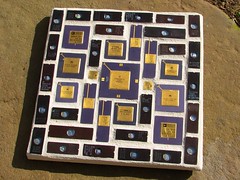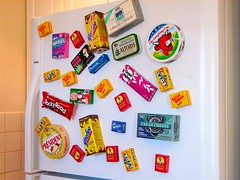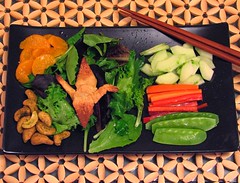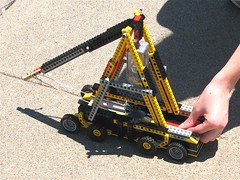The Koch Snowflake is a neat fractal shape… that you can make in your kitchen.
Category Archives: Art
South Indian Restaurant Menu Decoder Ring
For years, we’ve enjoyed eating out at South Indian restaurants– they often have exceptionally interesting food. They are almost invariably vegetarian, so it is generally safe– even for non-carnivores –to order anything off of the menu.
But here’s the rub: the menus tend to be terse. Many of them have only a list of items, without description at all (Tirupathi Bhimas has an excellent example). It’s not clear if this is because they don’t expect “outsiders” to want this kind of food, or perhaps some other reason, but restaurants with clear descriptions of the menu items are the exception, not the rule.
Moreover, the waiters aren’t always trained to give explanations to non-Indians. If you ask what the difference between a dosa and a rava dosa is, you might hear that rava dosas are crispier. But your waiter may not know that rava means wheat or be able explain that in a rava dosa semolina replaces the rice flour. And that won’t help you if you don’t already know that a dosa is a large crispy crepe made with a fermented batter of rice flour and ground lentils. The semolina in a rava dosa does make it crispier, and a little thicker than a regular dosa. It also takes a little longer to cook, so you can expect it to come out of the kitchen a bit later than a regular dosa.
That little bit of trivia may stick in your mind for a short while, but will you remember it the next time you are at the restaurant? (Will we?) And what if you can’t remember what uthappam is? Some restaurants include more information on their website than they do on their printed menu (Saravanaa Bhavan [pdf] and Udupi Palace are good examples) but it would be a hassle and require planning to print out their online menu to take with you.
So you need a decoder ring! Or at least a wallet card. With a little help from Wikipedia (check out their page on curry!) and the glossary in my copy of 1000 Indian Recipes, we’ve put together a South Indian Restaurant Menu Decoder Wallet Card (800 kB PDF) for your enjoyment, education, and dining pleasure. You can print it out– single sided so no hassle –and it compresses to standard business card size: 3.5″ x 2″. You can also not print it out, and just view it on your iPhone. (And if you’ve never been to a South Indian place, isn’t this a good time to try one?)
A note on spelling and vocabulary: India is big. Many ingredients and dishes have different names in different regions, languages and dialects. Spellings vary a lot. I have used some of the more common variants, and tried to use multiple versions where the variance seems significant to me. I used versions that I have seen on menus in my area. I have not included all of them. If it sounds similar, it probably is.
A note on my definitions: I tried to include enough information to be useful, not so much as to be tediously accurate. My translations are gleaned from lots of sources, including my own experience and experimentation. Space considerations for the wallet card have led to some compromise on absolute accuracy. But I’m not Indian or I wouldn’t be writing this, so if you see something that’s blatantly wrong, please let me know.
We’d love to see wallet decoder cards for other kinds of restaurants, so let us know if you make one! Korean? Pakistani? Where else do we need one?
Improved Custom Message Hearts
In some ways, we really like candy message hearts. They make good ammo, you can stamp them with your own messages, they make halfway decent sidewalk chalk, and they do bizarre things if you cook them.
On the other hand, you may or may not like the way that these things taste. (To us, many years ago, they compared very favorably to the other varieties of sidewalk chalk that we had tried.) In either case there is certainly some room for culinary alternatives.
Read on and learn how to make your own highly edible custom cookie message hearts.
Vector Snowflake Application
A new application to draw your own snowflakes and save them in PDF format. Clean, cross-platform, open-source, and able to generate closed-polygon vector shape output. Oh yeah.
Now that’s an Apple Pie!
With a little help from a square springform pan, you too can have an Apple apple pie for dessert!
Continue reading Now that’s an Apple Pie!
Binary Birthday
I am this many.
Have you ever heard of the unary number system, i.e., base-1 numerals? That’s the formal designation of tally marks– a means of representing a number symbolically by using symbols, where the number represented is equal to the number of symbols. While easy to grasp, it’s also a rather inefficient system, so we don’t find too many uses of them in modern life. One of the places that we do (almost) always use the unary system is on birthday cakes, where a birthday cake has one candle per year. This is fine for small numbers, but positioning, lighting and blowing out candles becomes impractical past a certain point.
Here’s a better way: A binary birthday candle. It consists of a single candle with seven wicks, where the wicks that are lit represent the birthday individual’s age in binary. This single candle design works flawlessly to represent any age from 1 to 127, never requiring anyone below the age of 127 to blow out more than a mere six candles at a time.
Continue reading Binary Birthday
Edible Googly Eyes in the New York Times
Our Edible Googly Eyes recipe (original post here) has made it to the New York Times to accompany an article about The Hungry Scientist Handbook. Woo-hoo!
Maker Faire Austin Pictures
We had a wonderful time at Maker Faire Austin. I’ve put some pictures and videos up in this flickr set for your enjoyment.
Our neighbors at Maker Faire were Kris and Carly who were doing very fun things with LEDs, like making Monopoly more fun by lighting up when you land on certain squares. The no-solder wiring system was very clever, and the flashing blue and red lights in jail were perfect.
This cute little robotics platform stopped by for a visit, but in order to see most of the rest of the faire we had to pry ourselves away from our table, which was tough. There was a nice collection of art cars, including this Chia Car. Maker Faire is wonderfully overwhelming, and we didn’t take very many pictures. Luckily, many other people took pictures too, and you can check lots of them out on flickr.
High Cuisine for Halloween: Eyeball Caprese
Insalata caprese, an Italian classic, becomes an instant halloween classic as well.
The traditional ingredients for this delicate salad are fresh mozzarella, basil, plum tomatoes and olive oil, seasoned with salt and pepper. Our version goes only slightly further, adding a thin slice of olive as the garnish. And, a clever trick produces perfectly round pupils every time.
Continue reading High Cuisine for Halloween: Eyeball Caprese
The Hungry Scientist Handbook
 Today is the official release date for the Hungry Scientist Handbook, a new book by Patrick Buckley and Lily Binns.
Today is the official release date for the Hungry Scientist Handbook, a new book by Patrick Buckley and Lily Binns.
The Hungry Scientist Handbook was conceived as a sort of cookbook for geek-centric food and– using the word a different way– as an a cookbook for food-oriented electronics– as evidenced by projects varying from polyhedral pies to LED lollipops.
We met Patrick and Lily at the 2006 Maker Faire, where they invited us to contribute a couple of chapters to their project. We did, and it’s finally out!
(We aren’t the only ones who are excited– we’ve seen write-ups at the LA Times and
Wired this week.)
We contributed a total of nine projects to the Hungry Scientist Handbook, some of which we have written about here. These include the Computer Chip Trivets, Crafty fridge magnets, Edible Origami, and (making a cameo appearance) the Lego Trebuchet.
We also contributed a few new cooking projects that involve dry ice: Dry (Ice) Martinis, Fizzy dry ice lemonade, and Dry ice root beer. (With Floating bubbles on CO2 as a bonus project.)
And… a brand new exclusive Evil Mad Scientist Laboratories electronics project that we developed just for the Hungry Scientist Handbook: Smart Coasters.
Smart Coasters are cast-plastic coasters for your drink that light up red when you put a hot drink on top and light up blue with a cold drink. The design is fully analog– no microcontrollers and no programming– and they incorporate a solar cell so that the whole thing is hermetically sealed: waterproof and washable. Complete step-by-step DIY instructions are included for both the electronics and the resin casting.
You can purchase the Hungry Scientist Handbook at booksellers including Amazon. Also visit their new web site, www.hungryscientist.com.



























